
How often do you underestimate the amount of time an assignment will take?
Do you feel like you need to be driven by a frenzied panic to get your work done?
There is a better way.
If you’ve had enough of pulling all-nighters, then it’s time to learn how to create effective study plans and prioritise your work.
I know what you’re probably thinking, “Ugh. Study plans”. It’s hard enough to actually sit down and study, let alone create a study plan, right?
I used to think that study plans were something only super studious and organised students created (I was just winging it).
It wasn’t until I reached university that I discovered study plans are for everyone, especially for students who lack motivation, get easily distracted and feel incredibly lazy (that was me!).
The great news is you don’t have to be a genius to create study plans that work.
You can even create a study plan while watching Cat Videos on YouTube. It’s really that simple.
In this article we’ll explore:
Why bother to create a study plan?
Plans create structure in our lives. They can give us a routine to follow. They can force you to think through all the steps of a project, to break things down and to consider when and where you’ll find time to carry out certain tasks.
Many students report feeling more in control of their studies and less stressed and overwhelmed after creating a study plan.
How to make a study plan
Have your teachers handed you a template that looked like this?
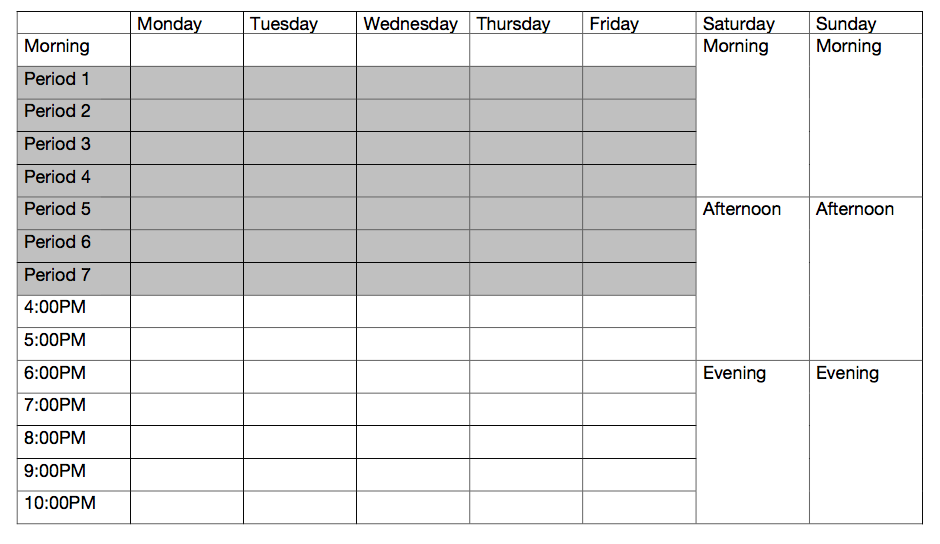
Most likely they told you to fill it in with all your extra curricular activities (e.g. soccer practice, guitar lessons and Homework club). Then they would have told you to factor in some free time and schedule in your study time around that.
If you’re like most students, you would have stuck at it for a few days before getting derailed and abandoning the schedule altogether.

If this has happened to you, don’t despair. Filling in a study template is only one way to create a study plan (and I’m not convinced it’s the best way). Let me show a more effective way to create a study plan/schedule …
The List Approach
This study planning methods requires you to make several lists but don’t be put off by this. It takes me between 5-10 minutes to make my lists and I get that time back plus more as a result of creating the lists in the first place. So stay with me because this approach can be a game changer (it certainly was for me).
Here is the list of lists:
1. A weekly list of tasks (no more than 20 tasks)
2. A daily list of five
3. A list of one (optional)

Below I explain each list in more detail:
1. Weekly list of study tasks

You make this at the beginning of the week. This list contains all the key tasks you need to perform for the week. Restrict this list to no more than 20 tasks (there’s only so much you can do in a week).
For this list, I use a yellow notepad on a clipboard rather than any old sheet of lined paper. Why? It needs to stand out amongst all my other papers.
But don’t stop here. A list of 20 is far too overwhelming for most of our brains. You need to break it down.
Enter the list of five.
2. The daily list of five

Choose five important or urgent tasks from your weekly list. This is all you need to focus on today.
How do you know if a task is important or urgent? Here’s how I define it for myself:
Urgent: this task needs to be done right away. You can’t afford to faff around. There’s a deadline (e.g. it’s due tomorrow) so if you start tomorrow, it will be too late.
Important: There is some kind of reward associated with doing the work. Or a negative consequence if you don’t do it. Ask yourself the question, “What will happen if I don’t do this task?”
Tim Ferriss has a clever strategy he uses to help him figure out the most important tasks for each day. He asks himself the question, “What are 3-5 things that are making me feel most anxious and uncomfortable?” You should probably try to knock these things off (unless there is a task with a more pressing deadline).
I write my list of five out on a palm card. I put it in my pocket and regularly take it out to review it to make sure I’m on track throughout the day.
What happens if you get distracted? Don’t beat yourself up. It’s super easy to get derailed. Just refocus on what you need to do.
Dr Barbara Oackley recommends you create your daily list the evening before. She states:
“Why the day before? Research has shown this helps your subconscious to grapple with tasks on the list so you figure out how to accomplish them.”
3. The list of one (optional)
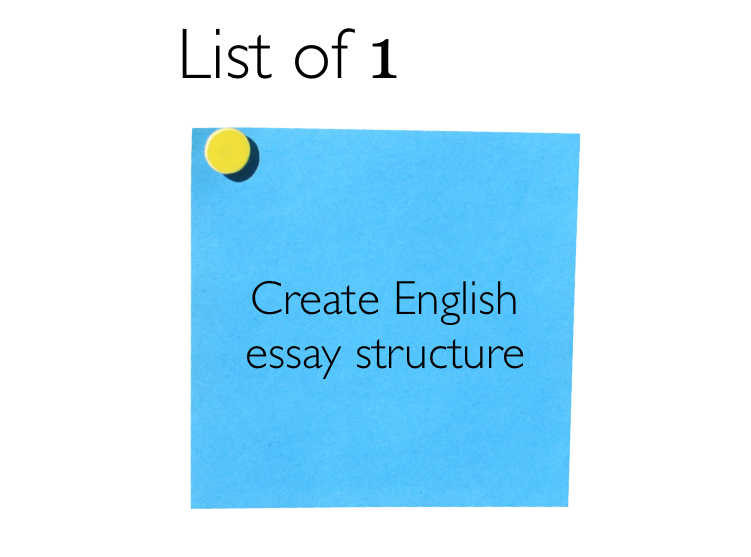
If you’re like me, a list of five is still far too overwhelming to look at. This is where the list of one can help.
Look at your list of five and choose the most important and/or urgent task.
Now write this task down on a post-it note. Put your list of five away in your pocket and place your list of one in front of you. If you have a whiteboard, write the task in big letters to help you stay focused.
This task is all you need to worry about doing. Forget the rest until you’ve finished the task on your list of one.
Making lists (over and over again)
Don’t be afraid to recreate your lists over and over again. As Dr Douglas Puryear shares in his excellent book Your life can be better:
“I make lists over and over, all day long. It’s not just about having the list; there is also benefit in making them. Writing down what I need to do is somehow calming and organizing, and therefore motivating. When I write things down, it’s as though I’m on top of them.”
So if your list of five isn’t working for you or is looking a bit scrappy, create a new one!
But making your plan/lists is only the start …
Once you’ve made your list you need to take action. The act of making the list will make you feel on top of everything but this can be a trap.
Have you ever made a plan and then thought, “I’ve done enough for today. I’ll get started on this plan tomorrow”? If you have this thought after making a plan, alarm bells should be going off. You’re about to procrastinate!
Remember, even with your list of five (or list of one), nothing will actually get done unless you take action.
Take immediate action by getting specific
If an item on your list says, “Write essay”, this is way too vague for your brain.
With vague goals, your brain says, “Meh. This isn’t important. I’ll do it tomorrow”. But if your list item says, “Create mind map structure of English essay”, your brain is more likely to think “This is important! Let’s get cracking!”.
Can you think of five specific tasks you need to do today? Get the ball rolling by posting your list of five (or your list of one) below!
Share This:
Procrastination feels heavy.
But what if we could turn combating procrastination into a fun game?
Lately, when I catch myself avoiding a task, I’ll play a little game to see if I can get myself to move in the right direction.
I’ve discovered that it’s best to approach any task with a curious and playful mindset. If you take yourself too seriously, all the joy and fun can get stripped from the process.
Often, when I play this game, I surprise myself because the strategy works! I’ll be off and running with a task I procrastinated on for days.
But sometimes a strategy won’t work. That’s okay. When this happens, I usually take a little break before trying another approach.
I don’t claim to be a grandmaster at playing the game of combating procrastination. But these days, I can catch myself when procrastinating, notice the warning signs, and get moving in the right direction.
In this blog, I share how you can combat procrastination in a fun and playful way to fulfil your intentions and accomplish your goals.
Are you ready to play?
Let’s begin!
If you want to play this game of combating procrastination, you first need to understand what procrastination is and the rules of the game.
I recommend you play this game on your own so you’re not competing against anyone else. There’s no first or second place, no runners-up, and no one wins a trophy.
You can play with others, but it’s a collaborative game where you cheer each other on and gently coach each other into action.
It’s also a game that never ends because the work never ends. You are constantly learning and growing.
In her book ‘Procrastination: What it is, why it’s a problem and what you can do about it’ Dr Fuschia Sirois defines procrastination as:
“ . . . a common self regulation problem involving the unnecessary and voluntary delay in the start or completion of important intended tasks despite the recognition that this delay may have negative consequences.”

In other words, procrastination is:
Delaying a task + you know you are causing your Future Self pain and suffering.
There are some simple rules you need to understand to combat procrastination. Once you cement these rules in your brain, life becomes easier. Instead of experiencing constant resistance, you discover ease and flow.
Difficult work tends to bring up unpleasant emotions, such as boredom, stress, anxiety, fear, and frustration.
Most of us don’t like experiencing these feelings, so to repair our mood, we procrastinate. We avoid work and engage in easier, more fun tasks (e.g., scrolling through social media).
At the heart of combating procrastination is allowing yourself to sit with unpleasant feelings and push past them. Resist the urge to run to your devices. If you can do this, that’s 80% of the battle.
Pushing through the discomfort and making a start is a significant milestone worth celebrating.
Often, we wait for the perfect time to start a task. But it’s an illusion that there is a perfect time.
The perfect time is right now, amid the messiness and chaos of life.
“But I’m not feeling motivated!” I hear you say.
That’s okay. Make a start regardless of how you feel because here’s the part most people don’t understand:
Motivation follows action
In other words, you have to get moving for motivation to show up.
There are many great strategies and tools that can help you get started with a task, even when your motivation levels are low.
Once you have a selection of strategies and tools and you’ve practised using them a few times, you will feel more confident in your ability to combat procrastination.
Here are a few of my favourite strategies and tools for getting started with my work:
Fear is a significant driver of procrastination: fear that you won’t be able to do it, fear of failure, and fear of the unknown.
When you move your body, you decrease fear and anxiety. Movement can also help to calm and focus your mind and boost positive emotions.
This is why I start my day with a 20-30 minute run on my treadmill. It bathes my brain in feel-good chemicals, makes me feel stronger, and prepares me for the challenging work I’m about to face.
When a task feels big and overwhelming, it’s easy to procrastinate. But can you do 10 minutes on the task?
When I set a timer for 10 minutes, my brain thinks, “I can do 10 minutes. Easy!”
My brain then knows the task (and the unpleasant feelings) won’t last forever. The worst-case scenario is I experience 10 minutes of mild to moderate discomfort. When the timer goes off, I have a way out. I can do something else.
But what usually happens is after 10 minutes, I realise the task isn’t as bad as I thought it would be. The motivation has kicked in, and I’m on a roll.
When struggling to write my PhD, I attended a workshop led by an academic coach. She encouraged me to “Write crap” (her words, not mine).
This helped me to get over the perfection hump and make a start.
Most (if not all) great works started as rough drafts. The problem is we don’t see those rough early versions. We only see the polished final product. This messes with our minds and can lead to perfectionist tendencies kicking in.
Embrace the first messy draft. Celebrate it! You have to do it to get to the good stuff.
In the book ‘Everything in its Place’, Dan Charnas recommends the ‘Slow-but-don’t-stop’ technique for doing things you don’t want to do.
Here’s how it works:
If you’re feeling resistance towards a task, start doing it, but move very slowly. Breathe into the discomfort. Take your time.
Charnas writes that as you use this technique:
“You’ll still hate it [the task] but your task has become a moving meditation or like a game.”
For example, I used this strategy on the weekend to sort my laundry. The first step was to pick up the basket full of clothes and place it on my bed. Then, I picked up one item at a time and put them into piles (e.g., socks, activewear, and undies). I then selected a pile of items (socks) and dealt with one item at a time.
I’d usually rush to fold my clothes and feel slightly annoyed by the whole process (“Ugh, what a chore!”), but this time, it felt different. It felt like a meditation. I felt calm and grounded as I folded my socks.
The beauty of this technique is that the work will still get done, but as Charnas points out, you don’t give up control. You still have forward momentum.
As the Mexican proverb goes:
“An ant on the move does more than a dozing ox.”
Are there things in your workspace that distract you? Is there anything that reminds you of more fun stuff you could be doing (e.g., a video game console or your phone)?
Please get rid of those things or make them harder to access.
My phone is my biggest distraction. This is why I keep it away from my body in another room whenever I need to do focused work.
I’m currently experimenting with Mel Robbin’s 5-Second Rule. The 5-Second Rule is simple:
The moment you have the instinct to do a task before your brain can come up with an excuse not to do it, you count backwards ‘5 . . . 4 . . . 3 . . . 2 . . . 1!’ and you do it.
In her book ‘The 5 Second Rule’ Robbins explains the psychology underpinning the strategy. She writes:
“The counting distracts you from your excuses and focuses your mind on moving in a new direction. When you physically move instead of stopping to think, your physiology changes and your mind falls in line . . . the Rule is (in the language of habit research) a “starting ritual” that activates the prefrontal cortex, helping to change your behavior.”
The ultimate way to combat procrastination is to create a habit or a ritual. You need something that signals to your brain it’s time to engage in a particular behaviour.
With habits, you don’t have to stop and think, “What do I need to do now?”. Habits are automatic. Your brain knows exactly what it needs to do, and you do it.
For example, I have a habit of running on my treadmill before I launch into my day. My brain knows that after I put on my gym clothes and shoes, I turn on my treadmill and hit the speed button to start my warm-up.
I carry these behaviours out even when I’m not in the mood to run. That’s the power of habits.
Then, I suggest you cut yourself some slack.
Forgive yourself for procrastinating, pick a strategy, and get moving.
Most of us don’t do this, though.
We bag ourselves out in an attempt to motivate ourselves. The problem is this rarely works.
Dr Sirois says that intense self-criticism leads to negative thoughts, which lead to negative feelings. We end up feeling demotivated, which causes us to procrastinate even more!
You can stop the vicious cycle of procrastination by practising being kind to yourself.
If you follow these simple rules and be playful with experimenting with these strategies, you can get a better handle on procrastination.
Like anything in life, the key is practice. The more you practice allowing yourself to feel the unpleasant emotions instead of running from them, the better you’ll do. The more times you practice a strategy, the more natural it will feel and the sooner it will become a habit.
One foot in front of the other. You can do this.
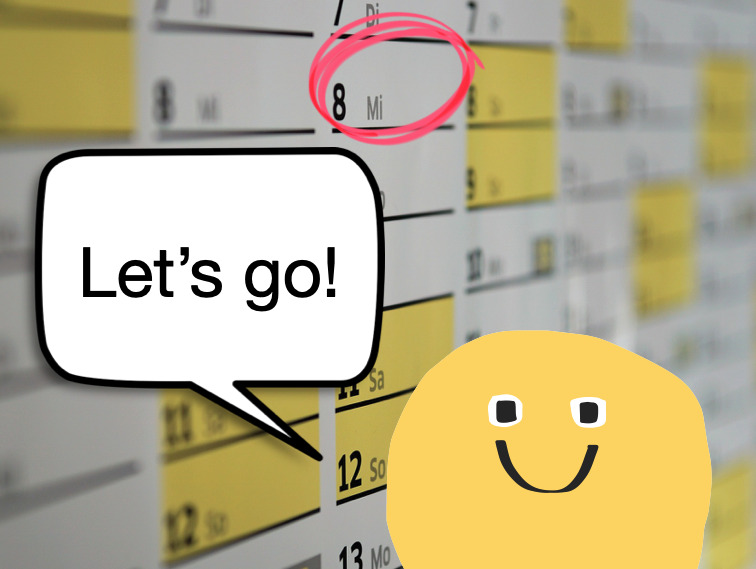
But how much time do you actually have?
It’s hard to get a sense just by thinking “My exam is in three weeks.” After all, three weeks sounds like plenty of time, right?
Don’t be fooled. This is your brain playing tricks on you.
No one ever has a full three weeks (504 hours) to prepare for an exam. Thrown into the mix is time for sleep, getting ready for school or work, working on assignments, socialising with friends and family, etc. Plus, you usually have more than one exam to study for.
But we can forget this. And when we do, we end up procrastinating with our work and it piles up for our future selves to deal with.
What’s missing is that your brain needs clear visual feedback. It needs to have a sense of the big picture (i.e., all your commitments laid out in front of it).
By using a year-at-a-glance calendar.
Earlier this year, I printed out a massive year-at-a-glance calendar (A0 size).
I scheduled all my upcoming presentations, holidays, important events (e.g., birthdays), deadlines, etc., onto the calendar and placed it in a prime position where I couldn’t miss it.
This calendar has made all the difference. It grounds me in reality, helps me feel more in control of my schedule, and gives me clear visual feedback. It also makes me think twice before I agree to take on a new project.
In the past, whenever I’ve said yes to a new opportunity, I haven’t always been grounded in reality. Too many times, I’ve been unintentionally cruel to future Jane.
Let me explain . . .
Back in 2016, I was on the home stretch with my PhD. The path forward was clear. After years of struggling with my PhD, the end was in sight. I was on track to hand in my thesis in a few months’ time.

But then something happened that threw me off course (well, erm, I threw myself off course).
I was asked by a company to run a series of workshops. Without even thinking, I said “Yes! I’d love to!”. It seemed like a great opportunity. One that was too good to pass up.
When I shared the news with my PhD supervisor, she seemed to think differently. Her face said it all: a mixture of concern and confusion.
“Why did you say yes to this? Do you need the money? What about your PhD? You’re so close to finishing”, she said.
The truth was I didn’t need the money. I said yes because without having my other commitments staring me in the face, I had all the time in the world. I was engaging in magical (delusional) thinking. I fantasised about having superhuman capabilities and being able to do it all.
I was wrong. There were only so many hours in the day, and something had to give.
To cut a long story short, pretty quickly the magical thinking wore off, and I regretted taking on the job. I had burdened my future self with a ridiculous amount of work and unnecessary stress.

But worst of all, I had delayed handing in my thesis by several months. A few months might not sound like much in the big scheme of things. But when you’ve been plugging away at a PhD for seven years, every month becomes precious. I risked losing momentum.
If I could teleport back in time and place a year-at-a-glance calendar in my office space, I like to think that I would have prioritised my PhD over the shiny new opportunity.
I recently finished reading an excellent book called ‘The Extended Mind: The Power of Thinking Outside the Brain’ by Annie Murphy-Paul.
In this book, Annie explores nine principles for expanding our intelligence (note: these principles are not taught in schools). She argues that instead of pushing our brains to work harder and harder, we can use our bodies, relationships, and surrounding environment to boost our cognitive abilities.

In the chapter called “Thinking with the Space of Ideas”, she writes:
“Whenever possible, we should offload information, externalize it, move it out of our heads and into the world. It relieves us of the burden of keeping a host of details “in the mind,” thereby freeing up mental resources for more demanding tasks like problem solving and idea generation.”
After reading this book, I understood why a year-at-a-glance calendar can be such a powerful tool. Seeing all your projects and commitments in one glance allows you to think smarter and more strategically.
These calendars also help to orient you in time. You can see how much time you have between now and doing the things you need to do.
Your projects and deadlines stare back at you every day. There’s no escaping them.
Seeing your life in this way also helps you to plan and pinpoint busy periods.
Here’s an example . . .
This month, I have more presentations scheduled than usual. This means I need to manage my energy levels, prioritise sleep, and eat healthily.
But a quick glance at my calendar tells me I have a few ‘free’ days before all these talks begin. I can use this time to cook a few meals to pop in the fridge and freezer to make life a little easier during this busier period.
One of the worst things I can do when I get busy is order takeaway food and sacrifice sleep to work. I refuse to do it as it always backfires. If I’m functioning at half capacity, my talks and work will suffer.
These calendars can also provide useful information to help you manage your energy levels, reduce ridiculous workloads, and avoid burnout.
Earlier this year, there was a week when I delivered more talks than usual. During this week, I found myself taking 15-minute power naps between talks to recharge before the next one. Even with all these power naps, by the end of the week, I felt tired. I drew a tired little emoji face on my calendar to represent this.
That tired emoji face is a constant reminder: you have mental and physical limits. Don’t overdo it.
It’s important to find a calendar that is both aesthetically pleasing and functional for you. This means you probably can’t just go to the shops and pick something off the shelf.
You could order a hard copy calendar online, but when the year is already well underway who wants to potentially wait weeks for their calendar to arrive in the mail?
You can purchase a digital download online and take it to your local print shop on a USB stick. Some templates display the month as a long list of days; whereas other calendars group the month into weeks, with each week on a separate line (see examples below).


Alternatively, you could buy a monthly calendar, cut it up, and stick it together.
One of my friends suggested I try doing this. I gave it a shot, but my calendar looked like a failed arts and crafts project (with messy bits of tape plastered everywhere). Plus, the boxes were too small and cramped my style.
After some trial and error, I purchased a digital download from Etsy for $20AUD and printed it A0 size for $10AUD. All up, my calendar cost me $30AUD – money that was well spent.
The bottom line is you have to figure out what works for you and how much you’re willing to spend.
• Write on the calendar when all your exams, appointments, special events, and major projects will take place.
• If you don’t yet know the specific dates of each exam, note the week they begin and assume the worst-case scenario (your exams will be sooner rather than later).
• Consider laminating your calendar so you can use whiteboard markers on it.
• If laminating is too expensive, use sticky notes and washi tape instead.
• You can mount your calendar on core-flute material or foam board to give it a sturdier structure.
• Resist the urge to put every detail on your calendar. Focus on the big project deadlines, appointments, exams, etc. The details for what and when you work on each project can go into your weekly planner and/or on your to-do list.
• If you have the wall space, consider printing your calendar A0 size (841mm x 1189mm). You want plenty of space to write in each box.
In our noisy world where we are bombarded with endless opportunities, many of us would benefit from embracing analog tools like the year-at-a-glance calendar. These calendars help to ground us in reality and focus our minds on what matters.
If you have a lot going on in your world and find yourself saying “Yes!” to every shiny new opportunity that comes your way, do yourself a favour and create a year-at-a-glance calendar. Having your commitments stare you in the face every day is a simple but powerful way to live with greater focus and intentionality.
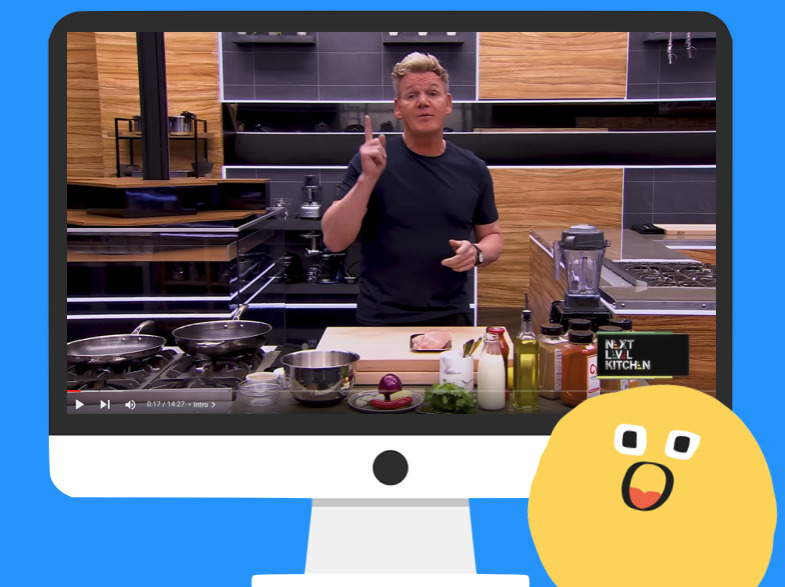
I recently watched a video of Gordan Ramsey cooking a ‘curry in a hurry’ (a butter chicken dish).
I was spellbound by the way Ramsey seamlessly cooked this dish. He was in flow and fully focused on the task of cooking the butter chicken.
What allowed him to whip up this dish plus a serving of rice in under 15 minutes?
Being organised helped a lot. Before he started cooking, chef Ramsey had all the ingredients and cooking utensils out on the bench, ready to go.
In chef’s speak, he had prepared the mise en place.
Mise en place is a culinary skill that can help us to study and work more efficiently. In this article, I explore this concept and how you can apply it to your life to help you stay calm, focused, and in control of your studies.
The mise en place is a French term that translates to “putting in place”. It means a place for everything and everything in its place.
Everything the chef needs is within arm’s reach. When it’s time to start cooking the dish, the chef knows where everything is. This allows the chef to focus on cooking the dish and stay calm and grounded under pressure.
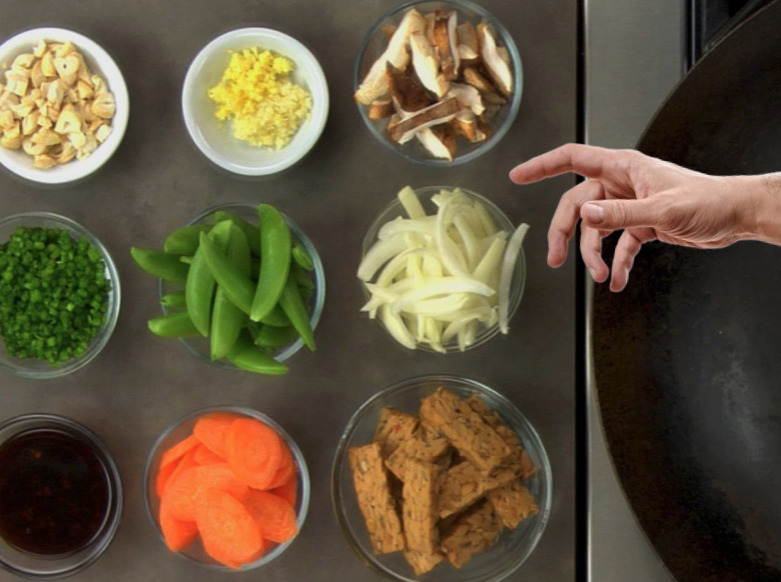
In the book Kitchen Operations (a textbook for hospitality students and apprentice chefs), the authors write about the importance of being organised in the kitchen. They state:
“The ability to work in an organised manner is possibly the most important quality that anyone working in the preparation and service of food can demonstrate. You must develop this ability to complete the expected workload in the time available. Failure to be methodical in your approach will reduce efficiency and will lead to feelings of stress and frustration.”
The mise en place helps the chef avoid unnecessary stress and frustration.
Imagine the following scenario . . .
A chef starts cooking a pasta sauce.
The chef realises 10 minutes in that he is missing a key ingredient (tins of tomatoes).
The chef has to run to the shops to buy the tomatoes.
Chefs can’t afford to have that happen. They are time-pressured. They need to get meals out quickly to hungry customers.
The mise en place helps chefs avoid stressful situations like this. It can also help you decrease unnecessary stress, drama, and frustration associated with homework and study.
Before starting your work, set yourself up with everything you need to complete the task.
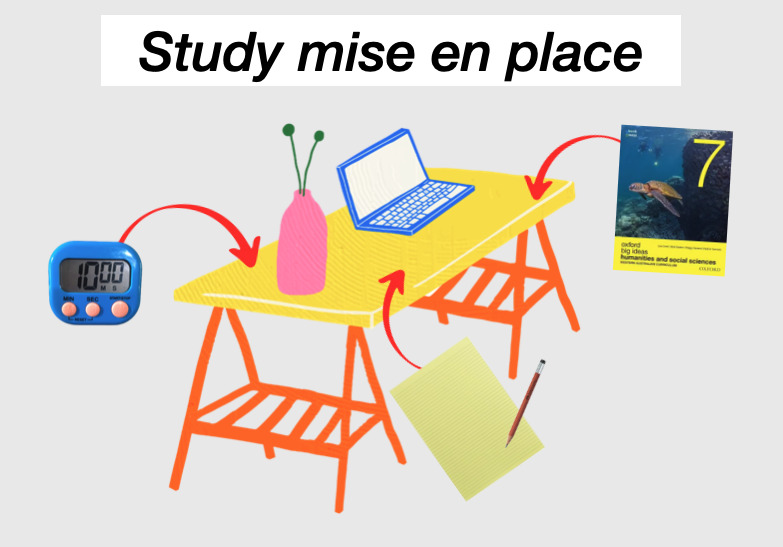
Think of this as the study desk mise en place. Ideally, you want to have a dedicated study space where everything is already set up. This saves you time, as you don’t have to set things up and pack things away after each study session.
But your desk isn’t the only space you can set up and prepare. In the world of study, you have other spaces you need to manage (e.g., a computer, school bag, pencil case, and locker). With each of these spaces, you need to ask:
“What items do I need in this space for my work to flow smoothly?”
It also helps to ask:
“What items don’t I want in this space?”
Just like a chef doesn’t want cockroaches, cats, and rats running around the kitchen and restaurant (or a visit from the local health inspector), there are things you want to keep out of your study space.
Remove anything that throws you off your game (i.e., makes you feel bad, distracted, overwhelmed, and upset) from your study space.
Here’s my list of things I want to keep out of my study space:
• My smartphone
• Long to-do lists
• Visual clutter
The point is to remove any friction points from your environment (anything that will slow you down and make it difficult to do your work).
The mental mise en place cannot be overlooked. This is the mental preparation part of the study process.
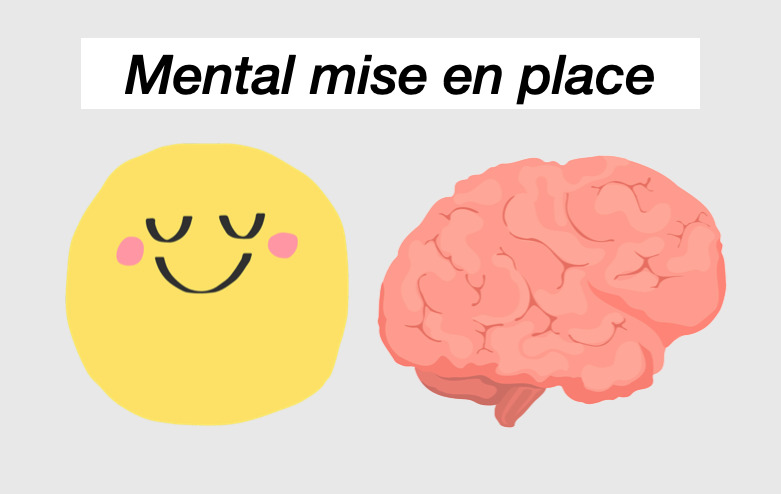
Ask yourself:
What must I do to mentally prepare myself for deep work/study?
Most of us can’t just scroll on our social media feed for an hour and launch straight into doing focused study. We need to get into the right headspace.
To be clear, I don’t mean you need to feel motivated, inspired, or in the right mood to study. Too often, we wait for motivation to strike, and it never comes. However, it certainly helps to be calm, focused, and grounded.
My mental preparation for the workday starts the evening before. Too many late nights have taught me that to wake up feeling calm and grounded, I need to go to bed at a reasonable hour.
When I wake up, I protect this mental calm by:
• Going for a walk or lifting heavy weights
• Doing a mini meditation (usually 3-5 minutes)
• Eating a healthy breakfast
• Avoiding checking my email and touching my computer first thing
• Journaling or mind mapping with pen and paper
I stay away from screens for as long as possible. This is essential for cultivating a calm mental state where I feel proactive and in control of my day.
I know I’m in trouble if I skip too many of the things on the list and start the day by checking my email. It becomes much more challenging to focus and get things done.
What is a pest of the mind?
It is anything that overstimulates the mind and leaves one feeling frenzied, scattered, and/or jangled.
Here’s the thing about learning information at a deep level: it requires you to slow down. You cannot rush it, like a 15-minute butter chicken dish.
But we engage with people, places, and things on a daily basis that speed up our thinking. In this overstimulated, wired mental state, learning feels like a hard slog.
Here’s a tip: start to notice the things that leave you feeling overstimulated. It can be incredibly liberating to cut back on these things or eliminate them completely from your life.
I am constantly tweaking my workspace and experimenting with different tools to help me click into a state of flow with my work. Here are some tools that I’m currently enjoying having as part of my study mise en place:
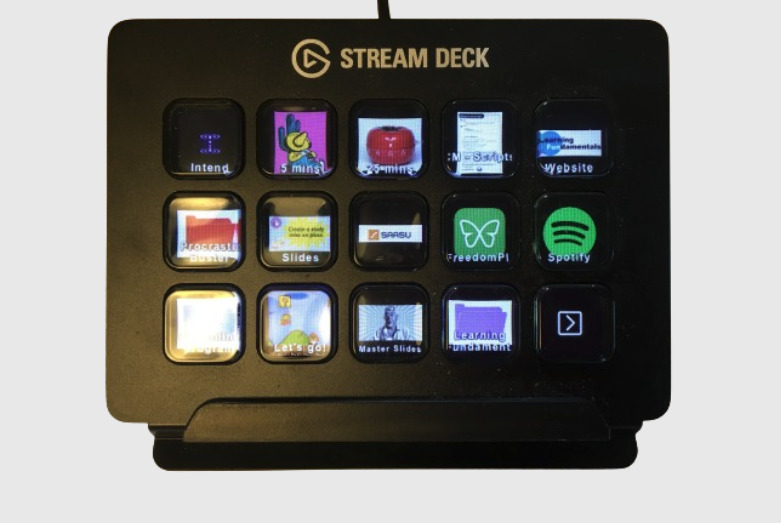
Technically, this is a gaming device that allows gamers who stream to switch scenes, adjust audio, etc at the tap of a button. I’m not a gamer, but I use my Stream deck to get started with various tasks and projects I feel resistance towards.
Instead of thinking, “Where is this file located? How do I get to it?” I tap a button on the Stream deck and it opens the file up. I tap another button, and it opens an application I frequently use.
No more frustrating clicking through numerous folders trying to find the document I need! The Stream deck helps to remove a big mental barrier and kick-start the work process with ease.
Stream decks aren’t cheap but if you can find one secondhand or on special like I did, they are well worth it.
Staying hydrated is super important. I fill a big jug with water every morning and place it on my desk with a glass. If water is within arm’s reach and I can see it, I find myself taking regular sips throughout the day.
I used nasty, cheap pens for years. Being a sucker for free stuff, I collected free pens at career expos and university open days. Without even realising it, these pens caused me a great deal of frustration and irritation.
These days, when it comes to pens, I don’t mess around with junk. There’s one pen I love using: the uniball signo (0.7). It’s a gel pen (you can find them at Officeworks). Writing with this pen is an absolute pleasure.

As Kevin Kelly says:
“Take note if you find yourself wondering “Where is my good knife?” or “Where is my good pen?” That means you have bad ones. Get rid of those.”
It’s super handy to have a notepad to jot down ideas and random thoughts as they arise. I recently discovered Rhodia notepads (a recommendation by The Pen Addict, Brad Dowdy). Writing on this paper feels like writing on butter!
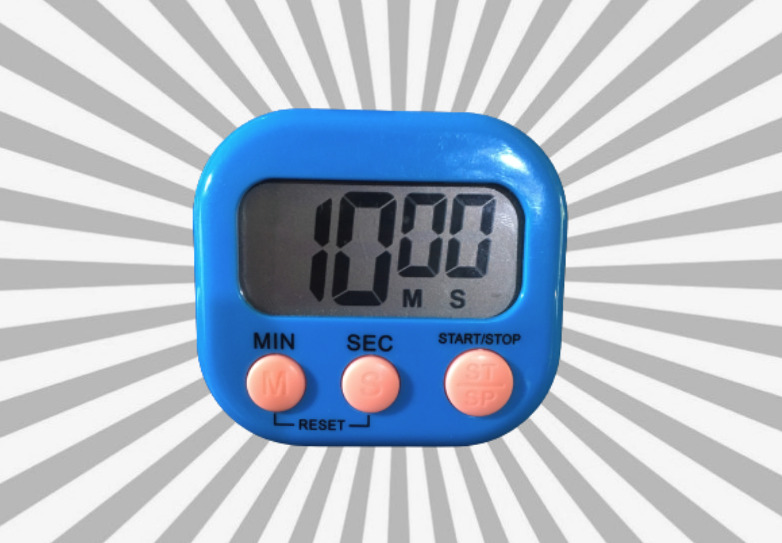
Whenever I notice I’m procrastinating, I’ll set my timer for 10 minutes and say, “All I need to do is 10 minutes on this task. That’s all. Just 10 minutes”. I set the timer and away I go.
Other times, when my workspace looks like a mess, I’ll set a timer for 3 minutes and spend that time getting things back in order.
My planner tells me what to do and when to do it. For the last 6 weeks, I have been experimenting with Cal Newport’s time blocking method (planning my day in hourly blocks). It sounds torturous, but it’s strangely liberating.
When I open my planner, I can see what is happening for the week, but I don’t have a sense of the bigger picture. This is why I printed out a massive (A0 size) year-in-a-glance planner to schedule all my presentations, holiday breaks, special events, etc.
Having this calendar makes me feel more in control of my life. I can see when I have busy periods of presenting and when I need to balance those periods with extra rest time to sustain myself. I can also see events and deadlines relatively to where I am now.
These are just a few things I love having in my study/work mise en place. But we’re all different, so you need to figure out what works best for you.
When I recently asked a group of high school students what items they would need in their study mise en place, here’s what they came up with:
• Snacks
• Phone
• Pencil case
• Squishmallows
The first three suggestions didn’t surprise me, but the squishmallows sure did (the students were shocked that I’d never heard of a squishmallow before). I had to google them (they are soft toys).

But I get it.
A squishmallow is fun.
It’s comforting.
It makes you feel good.
If something makes you feel good, go put it on your desk. Because if you feel good, it will be easier to think and learn.
The mise en place is a skill that can help all of us (not just chefs) focus on the task at hand. The point is you need to make your study mise en place work for you. You need to find the combination of ingredients that hits the spot.
Like a top chef has their favourite chopping knife, you’ll have your favourite pen. Spend some time experimenting with various tools and different work setups. By creating a more streamlined and organised study space, you’ll get that time back. Plus, you’ll find it’s much easier to get going and keep going with your work.
Dr Jane Genovese delivers interactive sessions on learning to learn, combating procrastination, exam preparation, how to focus in the age of distraction, habit formation and much, much more!
Get FREE study and life strategies by signing up to our newsletter:
© 2024 Learning Fundamentals